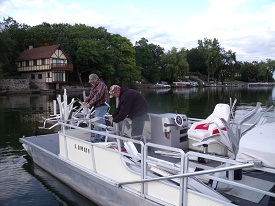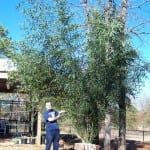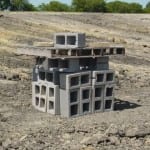http://underwaterfishphotos.blogspot.com/2012/06/artificial-fish-habitat.html
See the dozens of unique artificial fish habitat models, fish attractors and fish cover used at fishiding.com, the leader in proven science based, fish protection.
http://underwaterfishphotos.blogspot.com/2012/06/artificial-fish-habitat.html
See the dozens of unique artificial fish habitat models, fish attractors and fish cover used at fishiding.com, the leader in proven science based, fish protection.
See the dozens of unique artificial fish habitat models, fish attractors and fish cover used at fishiding.com, the leader in science based, proven, fish protection.
The lengthy period without fishing at the popular park adversely impacted attendance, said Kent Newcomb, the senior manager of the park south of Plant City and east of Valrico.
“These people want to go fishing,” Newcomb said. “A couple of years of no fishing is not what people want.
Now it’s time to get the word out: Anglers can cast a line again at Medard Park.
“It’s been stocked with bass bluegills, specs and catfish; we’re talking hundreds of thousands,” Newcomb said.
One change for anglers: The reservoir’s fish management plan allows catch-and-release fishing only, at least for now. Newcomb said he thinks the Florida Fish and Wildlife Conservation Commission may rescind that in a year or so, once the new fish population has stabilized.
Boat ramps, of course, have reopened. The daily launch fee is $5 per boat, and annual passes are available.
New at the park are canoe and kayak rentals, $25 for as much as four hours.
Additionally, the observation tower and boardwalk leading to it — popular vantage points for bird-watchers have been rebuilt — Newcomb said.
More than 30 years had passed since water of any magnitude had been drained from the enormous reservoir at the park off Turkey Creek Road. But deteriorating sandbags along the banks signaled it was time, and water levels began dropping after the dam was removed in November 2009.
Construction, begun in January 2010, was by a contractor for the Southwest Florida Water Management District.
“They just about drained it all the way out,” leaving only isolated pockets of shallow water, Newcomb said.
Then, 3,000 feet of concrete mats were strung across a berm to help form the shoreline. The rocks that previously lined the shoreline will become fish habitat — artificial reefs to help transform the manmade lake into a more natural habitat.
Keeping the shoreline intact ensures residents to the south will not get flooded if the berm breaches.
The project was intended to fortify reservoir embankments to protect against erosion and provide flood control, said Amy Harroun, a spokeswoman for the Southwest Florida Water Management District, which owns the reservoir.
Medard Reservoir provides flood control, as well as groundwater recharge and recreational benefits, she said.
“The project was a success; construction was complete in June 2010, and then we waited for rainfall to raise the water level,” Harroun said.
The project provided additional benefits.
At the urging of state Sen. Ronda Storms, the tons of tilapia and catfish removed from the reservoir were filleted and distributed to America’s Second Harvest, which provided it to local food banks to feed the hungry.
Additionally, fisheries biologists from the University of Florida removed and tagged large bass, which were relocated to other Florida lakes.
Newcomb, who has managed the park for 20 years and lives onsite, is as happy as anyone to have the reservoir reopened, as it attracts more than those who want to fish or boat.
“The water reflects on everything else,” including attendance by campers and picnickers, Newcomb said.
After the reservoir was drained, the park saw a sharp drop in attendance, which normally is close to 500,000 visitors a year.
“It’s still not back to what we hope it will be,” Newcomb said. “(But) I’m sure it will come back.”
Edward Medard Park and Reservoir
WHERE: 6140 Turkey Creek Road, Plant City
HOURS: 6 a.m. to 6 p.m. (winter hours)
ADMISSION: $2 per vehicle (eight people or fewer)
BOAT RAMP: $5 per launch
CAMPING: 42 sites with electricity, $24 nightly; $18 for ages 55 and older
CANOE/KAYAK RENTAL: $25 for four hours
INFORMATION: (813) 757-3802
gwilkens@tampatrib.com (813) 259-7124
| ||||
 |
| Published 17th Nov 2011 |
| http://www.youtube.com/watch?v=a15veu8Onlg&feature=player_embedded Members of the Sportsman’s club are at it again, enhancing their lake with more long term habitat, teamed up with Fishiding, 56 units of all varieties were dropped in a key area adjacent to spawning grounds. About 10 shallow Cradle models were sunk in 3-5 feet of water, with a line of Safehouse structures leading out to deeper water. The Cradle model consists of hundreds of fine strands of reclaimed PVC designed to give fry and baitfish areas to grow and hide from predators. When the fry have adequate habitat, they are given time to grow to the preferred size of 4-6 inches before venturing out into deeper water to become forage for predators.See the dozens of unique artificial fish habitat models, fish attractors and fish cover used at fishiding.com, the industry leader and only science based, man made and artificial fish habitat, proven to provide all fish with cover they prefer to prosper. The key is to make sure there is a continuous line or “tree row” of habitat from shallow spawning grounds out to deep water. If the fish have to swim from shallow areas out to deeper cover without cover to hide in, they get eaten prematurely, or before growing large enough to best benefit the larger predators like bass, walleye, crappie and musky. The club members clipped structurespot markers to each unit as it was dropped, to see where each one lands to ensure the continuous coverage. When all units are installed, they took some pictures to refer to the shape and design they created. After the pics, they simply pull the clip free on the structurespot markers and wind them up to re-use. The Safehouse models were installed from about 5 feet deep out to 8 feet and deeper where a huge cluster of the largest Keeper models were dropped. Algae begins to grow immediately in this dark, fertile water and the club will be fishing over them this winter through the ice. To date, over 125 fishiding fish habitatunits have been installed, with more being put together by members, donated by fishiding. Wonder Lake, at 830 acres, is the largest private lake in Illinois and Wisconsin. Through many different fund raising events, the club stocks fish twice a year as well as building and installing over 100 Wood duck houses, maintaining them and even video recording the hatching of chicks too. Annual lake cleanups, fish shocking surveys, carp derbys and kids fishing events are just a few of the things the club does for the lake and the community. |

On Friday, the department began placing fish habitats in the upper mile of the lake.
A press release said periods of heavy hydropower generation below the dam leaves “trout vulnerable to swift currents and (limits) fishing access for wade and bank fishermen.”
Newly installed structures in the lake will include boulder clusters, which should provide trout areas to rest and feed and provide anglers with more accessible fish habitats during periods of generation.
The project will be in conjuction with a drawdown of Lake Taneycomo requested by Empire District Electric Co., which will enable improvements to be constructed on Powersite Dam.
The department “plans to utilize this drawdown period to use large equipment near the lake to place the boulder clusters,” the release said.
Conservation officials will be at the project site to monitor the work and answer any questions from the public.
The department will use machinery to move the boulders into place, however, fishing will still be permitted in areas near where the work is being done.
The project is expected to conclude by the following Friday, Nov. 4.
The project is part of the Table Rock Lake National Fish Habitat Initiative, which is designed to maintain and improve fish habitats in Table Rock Lake and Lake Taneycomo.
This project is a joint effort of the Missouri Department of Conservation, the National Fish and Wildlife Foundation, Bass Pro Shops, the U.S. Army Corps of Engineers and other organizations.
It is designed to be a pilot project for a broader national program focused on habitat protection and restoration in reservoirs throughout the country.Tyler Francke
Visit mdc.mo.gov for more information on Missouri fishing.
See the dozens of unique artificial fish habitat models, fish attractors and fish cover used at fishiding.com, the industry leader and only science based, man made and artificial fish habitat, proven to provide all fish with cover they prefer to prosper.

Boat docks and old piers situated relatively close to deep water are very appealing to largemouths, particularly on reservoirs where aquatic vegetation is sparse.
Aquatic vegetation such as hydrilla, milfoil and coontail will year-in and year-out produce big stringers of bass on lakes across the United States. But by no means is that to say “grass” is the only thing that’ll hold viable concentrations of largemouths.
Shoreline structures will harbor good numbers of fish, too. This holds especially true on reservoirs that don’t have much aquatic vegetation, which in Texas includes many of our older, silted-in impoundments as well as those reservoirs geographically situated in areas that are not conducive vegetation growth.
Some of the more obvious forms of shoreline structure are boat houses, piers and docks. And truth be known, they are also some of the best.
Try as you may to find fish on other forms of structure like creeks, rivers, points and humps. If boat docks are available in substantial number on a lake where vegetation is sparse, that’s invariably where most of the bass are going to be caught and, where many of the tournaments are going to be won.
Now don’t be mislead, here. Not all docks are going to hold concentrations of bass. Some are naturally better than others, be it due to location, construction, size, age or a combination of the four.
Where a dock is located on a reservoir can a make a big difference in whether it will hold bass or not. It has been been my experience that structures built in the backs of creeks on top of shallow flats are the most reliable during the spring months. This this true mainly because they provide the fish some security for spawning.
Once spring gives way to summer, however, shallow docks lose some of their magic. Bass like to hang out close to deep water during the summer months, thus explaining why docks built in the mouths of creeks on mainlake and secondary points are usually the most productive. The ideal dock could be one situated in 8-10 feet of water along the edge of deep creek channel.
Another element to consider about boat docks is the manner in which they are assembled.
We do a lot of fishing around docks on Midwest impoundments during the summer months, and those “stationary” docks built on buried pilings are almost always more productive than those that float. The reason is that the pilings provide the fish with obstacles to relate to or hold against, which in turn means more targets to chunk at.
The size of an individual dock doesn’t make much difference when is comes to attracting bass, but it can sure have some influence on how many fish will be present.
As a rule, larger docks with several stalls will harbor more bass than one-boat units. Obviously, these types of docks will have more pilings beneath the surface for the bass to relate to, which means more good places to put a lure. Plus, the larger docks naturally provide the fish with more shade.
The age of the dock can also be critical. It has been my experience that older, more weathered docks tend to hold more bass than do new ones. These tend to have more algae growing on the framework, which in turn attracts bait fish. Older docks also are apt to have more brushpiles submerged around them. Dock owners often sink brushpiles to attract concentrations of crappie, but they act as bass hotels as well.
Some other telltale signs of a productive dock are lights, chairs and maybe a rod holder or two. These are all good indicators that someone fishes off the dock with regularity, which means there is more than likely going to be plenty of submerged brush in the area.
When I’m practicing for a tournament on an unfamiliar reservoir that has a good number of boat docks, I usually don’t spend near as much time looking for bass around docks as I do looking for brush. Find the brush and the bass will be there, sooner or later.
Depthfinders and LCR units definitely come in handy for locating structure. But when it comes to turning up brushpiles around boat docks, they aren’t of much use to me.
Probably the single-most effective technique I’ve found for finding brush around docks is the Carolina-rig. Not only does it allow me to probe an area thoroughly, but it enables me to do it quickly.
Once I locate some brush, then I’ll switch to a Texas-rigged plastic worm or Stanley jig/craw combo. My preferred worm in this case is a red shad, junebug or black/redflake Zoom Dead Ringer plastic worm or maybe a four-inch Big Critter Craw. A deep or medium-diving crankbait like the Norman Deep Little N is another option around docks. See the dozens of unique artificial fish habitat models, fish attractors and fish cover used at fishiding.com, the industry leader and only science based, man made and artificial fish habitat, proven to provide all fish with cover they prefer to prosper.
In summary, boat docks are man-made fish attractors. However, not all of them are going to hold bass consistently during the course of the year. The best summer docks are typically located adjacent to deeper, cooler water and they’ll have an abundance of brush submerged around them.
Find these docks and fish them correctly and you’ll invariably catch more bass, especially on reservoirs where they are available in abundance and grass is relatively scarce.

The US Army Corps of Engineers will host National Public Lands Day events at various lakes throughout the Pittsburgh District. In 2010, more than 500 volunteers came to 15 of 16 Pittsburgh District recreation projects and provided 2,179 hours of work valued at nearly $47,000. National Public Lands Day keeps the promise of the Civilian Conservation Corps, the “tree army” that worked from 1933-1942 to preserve and protect America’s natural heritage.
A local event at Mahoning Creek Lake will be held Sept. 24. This year the goal is to accomplish the building and placement of some fish habitat spawning boxes in the lake. If time permits, shore line clean-up will be done. Volunteers are asked to meet at 9:30 a.m. at the Milton Loop Campground pavilion, on Route 839, two miles north of Dayton.
See the dozens of unique artificial fish habitat models, fish attractors and fish cover used at fishiding.com, the industry leader and only science based, man made and artificial fish habitat, proven to provide all fish with cover they prefer to prosper.
The project will be to build wooden spawn boxes and then taking them by boat to place them in the lake. Event will take place rain or shine. Questions may be directed to Park Ranger Grover Pegg 412-719-9227.
The Ohio Environmental Protection Agency is coordinating a federal, state and local effort to develop 1,500 feet of fish shelf in the lower two miles of the river, an area best known for its hard-armored and sheet-piled riverbanks. The project will provide northern pike, muskellunge and other native fish species a shallow water habitat necessary for foraging and spawning. “We are nearly tripling the Continue reading “Fish Habitat Project Starts on the Ashtabula River”
